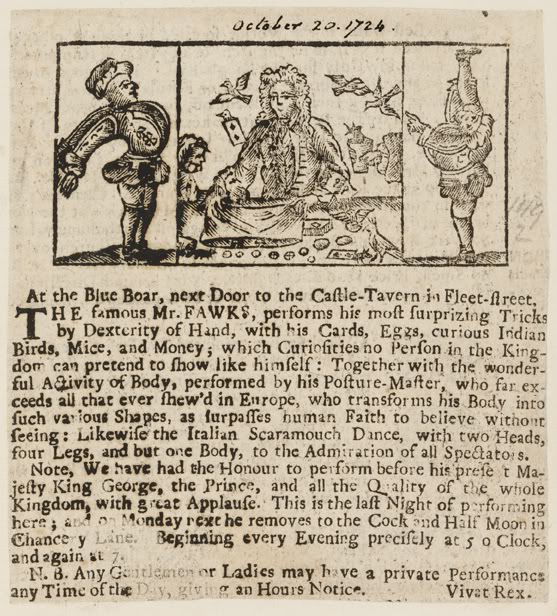|
Troublewit
Troublewit is a specially pleated paper used for entertainment purposes. The paper is used to form various items, such as hats, fans and umbrellas by stage entertainers and illusionists. Its origins go back at least to the 17th Century. The method of preparing the paper was described in English as early as 1676 by the anonymous author "J.M." in "Sports and Pastimes" but was said to be performed by a French monk "Pere Mathieu". British magic dealer Ellis Stanyon sold the folded papers ready-made and included a routine in his 1905 book, "Magic: or Conjuring for Amateurs," and an outstanding, photographically-illustrated routine was included in C. Lang Neil's "The Modern Conjurer" (1903). Houdini mentioned the novelty in his 1922 book "Paper Magic." According to Stanyon, "The groundwork of the paper-folding is not by any means new, having been known for several hundred years at least under various names, as: "Chinese Fan," "Fantastic Fan," "Trouble Wit," etc." According to Houdin ... [...More Info...] [...Related Items...] OR: [Wikipedia] [Google] [Baidu] |
Paper
Paper is a thin sheet material produced by mechanically or chemically processing cellulose fibres derived from wood, rags, grasses or other vegetable sources in water, draining the water through fine mesh leaving the fibre evenly distributed on the surface, followed by pressing and drying. Although paper was originally made in single sheets by hand, almost all is now made on large machines—some making reels 10 metres wide, running at 2,000 metres per minute and up to 600,000 tonnes a year. It is a versatile material with many uses, including printing, painting, graphics, signage, design, packaging, decorating, writing, and cleaning. It may also be used as filter paper, wallpaper, book endpaper, conservation paper, laminated worktops, toilet tissue, or currency and security paper, or in a number of industrial and construction processes. The papermaking process developed in east Asia, probably China, at least as early as 105 CE, by the Han court eunuch Cai Lun, although the ... [...More Info...] [...Related Items...] OR: [Wikipedia] [Google] [Baidu] |
Illusionist
Magic, which encompasses the subgenres of illusion, stage magic, and close up magic, among others, is a performing art in which audiences are entertained by tricks, effects, or illusions of seemingly impossible feats, using natural means. It is to be distinguished from paranormal magic which are effects claimed to be created through supernatural means. It is one of the oldest performing arts in the world. Modern entertainment magic, as pioneered by 19th-century magician Jean-Eugène Robert-Houdin, has become a popular theatrical art form. In the late 19th and early 20th centuries, magicians such as Maskelyne and Devant, Howard Thurston, Harry Kellar, and Harry Houdini achieved widespread commercial success during what has become known as "the Golden Age of Magic." During this period, performance magic became a staple of Broadway theatre, vaudeville, and music halls. Magic retained its popularity in the television age, with magicians such as Paul Daniels, David Copperfield, ... [...More Info...] [...Related Items...] OR: [Wikipedia] [Google] [Baidu] |
Ellis Stanyon
William Ellis Stanyon (January 1870 – September 1951) was a professional magician and magic dealer in London. History Stanyon published and edited his own journal known as ''Magic''.Evans, Henry R. (1902)''Magic And Its Professors'' George Routledge & Sons. p. 88 The journal's aim was to‚ 'popularize the Art of Sleight of Hand'. It was first published from October 1900 and ran for 177 issues with a break during World War I; the final issue was published in June 1920. Stanyon in his journal published a method of escaping from packed boxes. Biographer Kenneth Silverman has written that the magician Harry Houdini "accused Stanyon of having posted a bounty of several pounds for his secrets... Houdini dismissed the methods purveyed by Stanyon and others as being nothing like his own, "puny attempts at duplication."Silverman, Kenneth. (1996). ''Houdini!: The Career of Ehrich Weiss''. HarperCollins Publishers. pp. 65-66 Magic historian Henry R. Evans wrote that Stanyon was "one o ... [...More Info...] [...Related Items...] OR: [Wikipedia] [Google] [Baidu] |
Magic (illusion)
Magic, which encompasses the subgenres of illusion, stage magic, and close up magic, among others, is a performing art in which audiences are entertained by tricks, effects, or illusions of seemingly impossible feats, using natural means. It is to be distinguished from paranormal magic which are effects claimed to be created through supernatural means. It is one of the oldest performing arts in the world. Modern entertainment magic, as pioneered by 19th-century magician Jean-Eugène Robert-Houdin, has become a popular theatrical art form. In the late 19th and early 20th centuries, magicians such as Maskelyne and Devant, Howard Thurston, Harry Kellar, and Harry Houdini achieved widespread commercial success during what has become known as "the Golden Age of Magic." During this period, performance magic became a staple of Broadway theatre, vaudeville, and music halls. Magic retained its popularity in the television age, with magicians such as Paul Daniels, David Copperfield ... [...More Info...] [...Related Items...] OR: [Wikipedia] [Google] [Baidu] |


